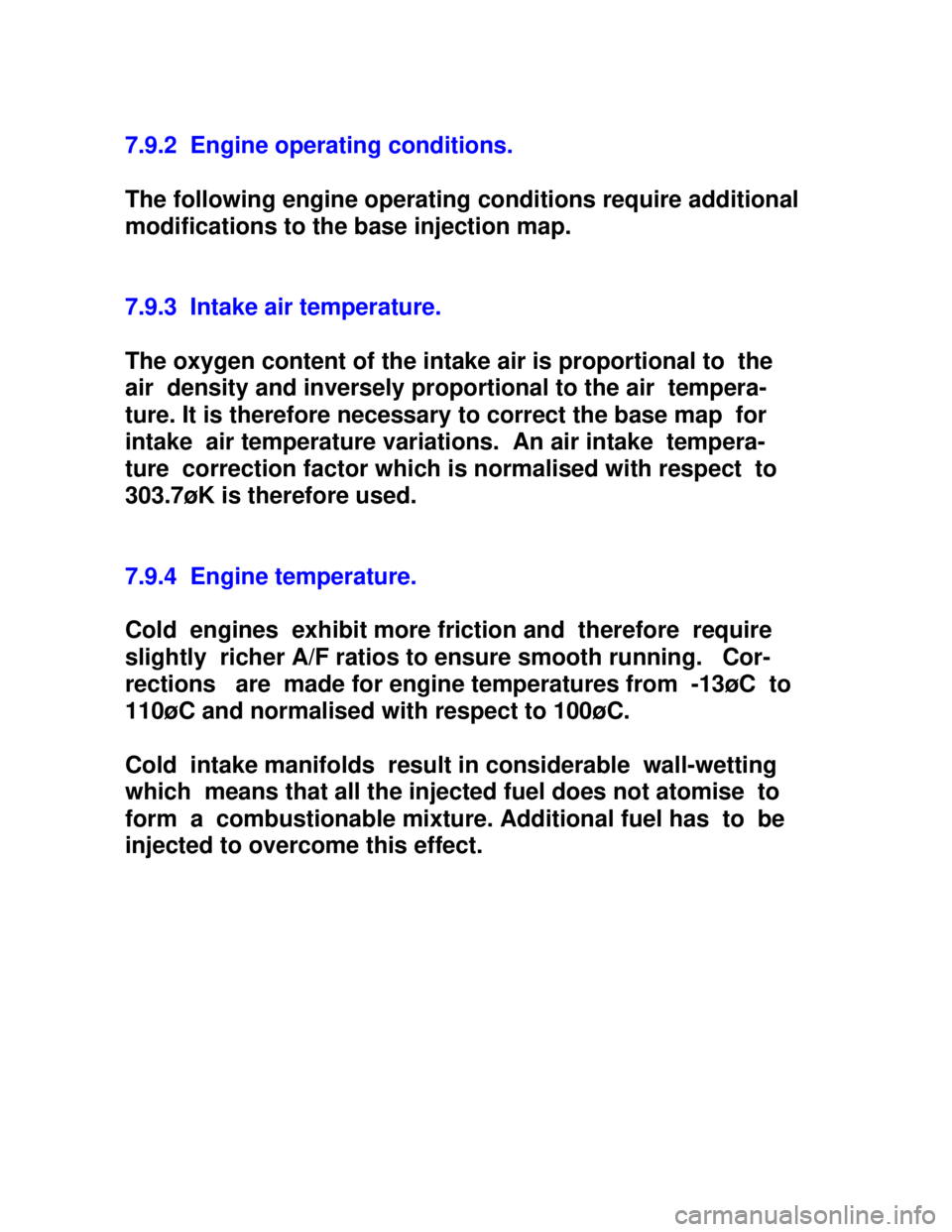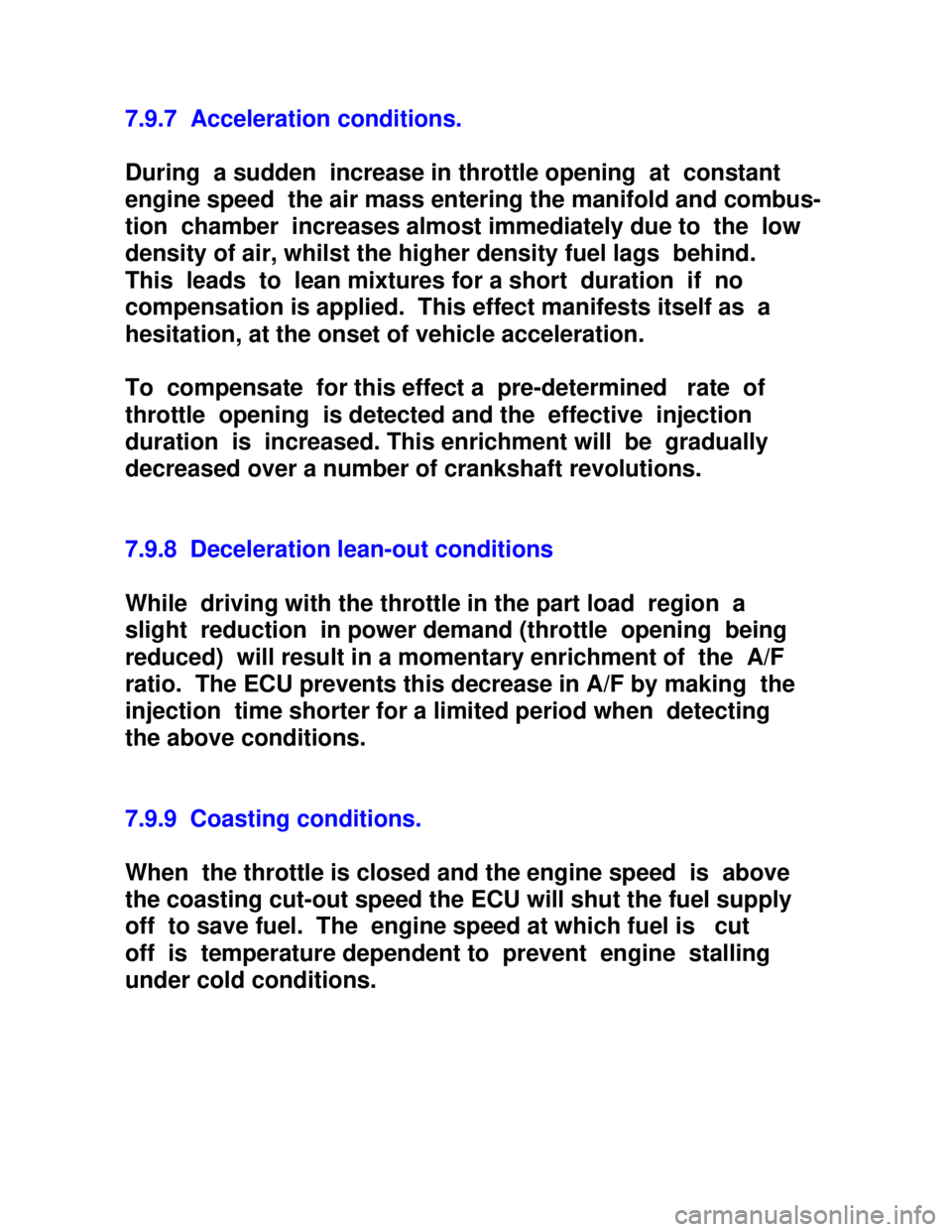Page 1052 of 1070

Downloaded from www.Manualslib.com manuals search engine 7.3 SPEED DENSITY CONCEPT
If we know the density of the air inside a container it is
possible to calculate the exact mass of the air inside the
container.
Am = Va*p Where Am = Air mass (g)
Va = Air volume (cc)
p = Air density (g/cc)
In an automotive FI application the quantity of fuel to be
injected can be calculated if the displacement volume of the
cylinder and the density of air within the cylinder at the
onset of the compression stroke are known.
The air density could be determined by measuring the abso-
lute pressure and absolute temperature of the air. In an
automotive application it is, however, not practical to
directly measure the air pressure and temperature inside the
cylinder. To overcome this limitation the air pressure and
temperature are measured in the inlet manifold. This leads
to certain pressure measurement errors for which corrections
have to be made.
To understand and correct these errors the engine is mo-
delled as an air pump. For the purpose of explaining these
problems one has to view the engine as a pump sucking air
from the inlet manifold through a restriction which is
formed by the inlet valve in the open position. The dynamic
properties of the air moving past the inlet valves are
engine speed dependent and to such an extent that the inlet
manifold pressure will tend to be slightly higher than the
in-cylinder pressure at the end of an inlet stroke. This
leads to higher than actual air mass measurements which
have
to be corrected. The air pumping efficiency is called the
volumetric efficiency of the engine.
Page 1057 of 1070

Downloaded from www.Manualslib.com manuals search engine 7.9.2 Engine operating conditions.
The following engine operating conditions require additional
modifications to the base injection map.
7.9.3 Intake air temperature.
The oxygen content of the intake air is proportional to the
air density and inversely proportional to the air tempera-
ture. It is therefore necessary to correct the base map for
intake air temperature variations. An air intake tempera-
ture correction factor which is normalised with respect to
303.7øK is therefore used.
7.9.4 Engine temperature.
Cold engines exhibit more friction and therefore require
slightly richer A/F ratios to ensure smooth running. Cor-
rections are made for engine temperatures from -13øC to
110øC and normalised with respect to 100øC.
Cold intake manifolds result in considerable wall-wetting
which means that all the injected fuel does not atomise to
form a combustionable mixture. Additional fuel has to be
injected to overcome this effect.
Page 1059 of 1070

Downloaded from www.Manualslib.com manuals search engine 7.9.7 Acceleration conditions.
During a sudden increase in throttle opening at constant
engine speed the air mass entering the manifold and combus-
tion chamber increases almost immediately due to the low
density of air, whilst the higher density fuel lags behind.
This leads to lean mixtures for a short duration if no
compensation is applied. This effect manifests itself as a
hesitation, at the onset of vehicle acceleration.
To compensate for this effect a pre-determined rate of
throttle opening is detected and the effective injection
duration is increased. This enrichment will be gradually
decreased over a number of crankshaft revolutions.
7.9.8 Deceleration lean-out conditions
While driving with the throttle in the part load region a
slight reduction in power demand (throttle opening being
reduced) will result in a momentary enrichment of the A/F
ratio. The ECU prevents this decrease in A/F by making the
injection time shorter for a limited period when detecting
the above conditions.
7.9.9 Coasting conditions.
When the throttle is closed and the engine speed is above
the coasting cut-out speed the ECU will shut the fuel supply
off to save fuel. The engine speed at which fuel is cut
off is temperature dependent to prevent engine stalling
under cold conditions.
Page 1064 of 1070
Downloaded from www.Manualslib.com manuals search engine 11 DIAGNOSTICS
Various possible methods of fault finding are listed below
to reduce down-time of the vehicle.
11.1 Diagnostic codes
The CPU continuously monitors its own activities and sensor
inputs. If a fault is detected during operation the diagnos-
tic lamp is turned on and a default signal value is used to
allow the car to be driven with slightly reduced perform-
ance. The fault code is stored in RAM for later evaluation
by the Dealer. If the fault disappears the unit will immedi-
ately use the sensor data instead of the default data, thus
ensuring optimum performance. The fault will be erased from
RAM after 7 starts (ignition turned on 7 times) during which
no fault was detected.
The fault stored in RAM could be accessed by grounding the
diagnostic initialisation input terminal. The fault will
then be flashed out by the diagnostic lamp.